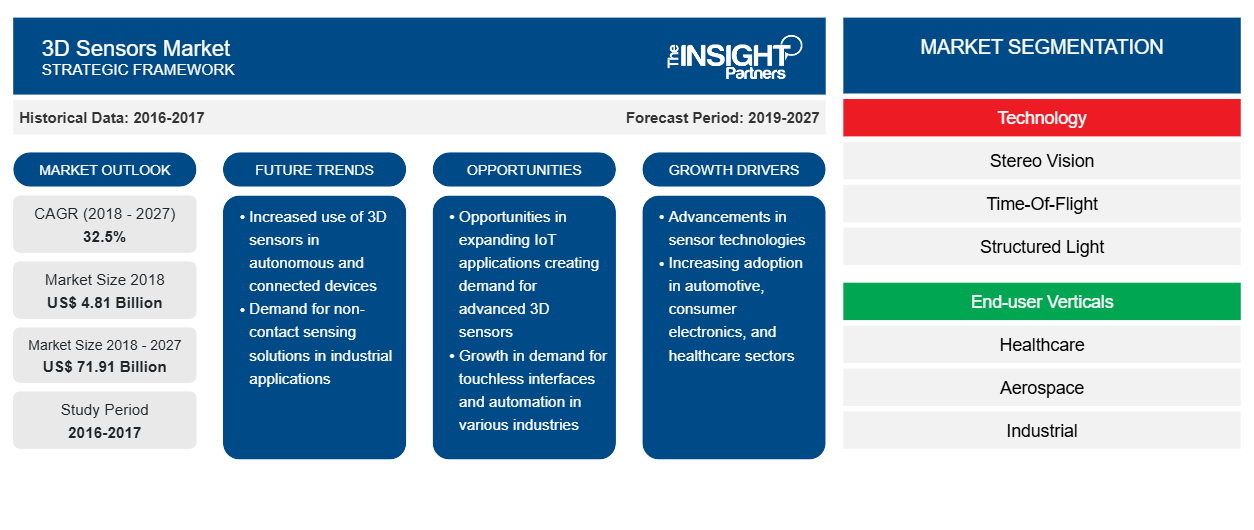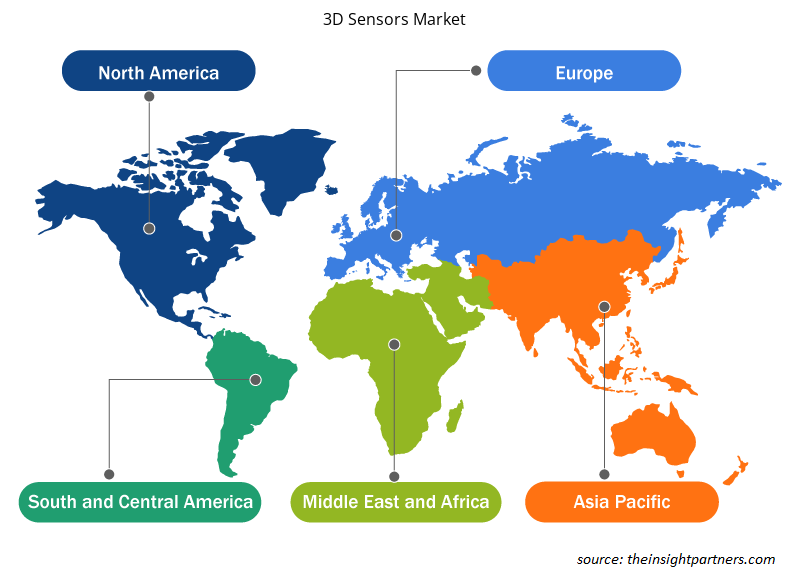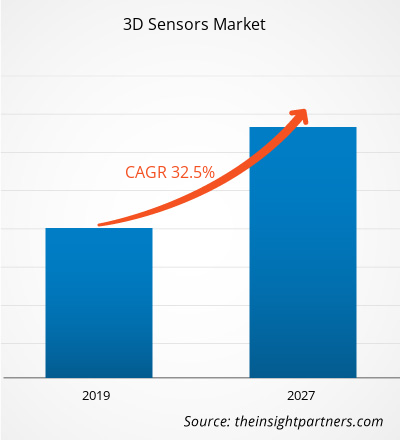[Research Report] The 3D sensors market was valued at US$ 4,805.7 million in 2018 and is projected to reach US$ 71,914.2 million by 2027; it is expected to grow at a CAGR of 32.5% during 2019–2027.
3D sensors use active-range sensors that provide depth images at high frame rates. These cameras are equipped with an IR light source that illuminates the field, and a CMOS/CCD sensor that captures the reflected IR light. The depth measurement is based on the ToF principle; thus, the depth is proportional to the time spent by the IR signal to reach the object or filed of observation and come back. The depth measurements obtained for each pixel of the sensor together produce a depth image. The fast acquisition of depth images is of great use in a wide range of end-user verticals, such as robotics, human–machine interaction, and scene modeling. Unfortunately, many of the currently available ToF cameras have low resolutions and are affected by different measuring errors, including noise caused by sensors, systematic wiggling error due to the difficulty of generating sinusoidal signals, a non-linear depth offsets dependent on reflectivity and integration-time, and the flying pixels generated by the superposition of signals at depth inhomogeneities (edges). As a result, ToF sensors provide accurate and precise depth measurements. The currently available multi-ToF sensor systems focus on combining depth images to build 3D reconstructions by relying on occupancy probability grids or registering the point clouds generated from different views, etc.
The ToF techniques have been in use for more than a decade for ranging purposes. SONAR and RADAR are the two techniques that exploit sound and radio signals of ToF principles, particularly in aerospace and aeronautic end-user verticals. More recently, with the improvement and the maturity of electronic devices, it has been possible to employ light signals for ToF systems. End-user verticals using such a system are numerous, especially in industrial and consumer fields. In general, there are two techniques of measuring distance with modern ToF sensors: pulsed-modulation or continuous-wave (CW) modulation. Advanced ToF systems deploy multi-frequency technologies, combining more modulation frequencies.
Customize This Report To Suit Your Requirement
You will get customization on any report - free of charge - including parts of this report, or country-level analysis, Excel Data pack, as well as avail great offers and discounts for start-ups & universities
3D Sensors Market: Strategic Insights

- Get Top Key Market Trends of this report.This FREE sample will include data analysis, ranging from market trends to estimates and forecasts.
You will get customization on any report - free of charge - including parts of this report, or country-level analysis, Excel Data pack, as well as avail great offers and discounts for start-ups & universities
3D Sensors Market: Strategic Insights

- Get Top Key Market Trends of this report.This FREE sample will include data analysis, ranging from market trends to estimates and forecasts.
Market Insights–3D Sensors Market
Increased Demand for Smart Consumer Electronics
The consumer electronics industry is witnessing immense growth in both developed and developing countries, and advancements and smart features that are offered by the manufacturing companies have been the major contributors to this growth.
Currently, various consumer electronics devices are used by individuals for a plethora of tasks. Consumer electronics such as smartphones, tablets, PCs, TVs, washing machines, fridge, and music players have become integral part of routine lives. All these devices are becoming smarter with the ongoing technological advancements and integration of Internet of Things (IoT) and Artificial Intelligence (AI). The advancements in the sensor technology has paved the way for remarkable growth of IoT and AI in most of the technological arenas including the automotive sector. The market for consumer electronics devices is constantly growing with the manufacturers coming up with advanced technologies and features in their devices on a regular basis and rising disposable incomes of users in the developed and developing economies.
Some of the prominent smartphone manufacturers have pioneered the integration of 3D ToF sensors into their smartphone models. Leading global smartphone manufacturers such as Huawei, Samsung, Oppo, LG, and Apple are the pioneers in the integration of 3D ToF sensors into various models. Huawei P30 Pro, Samsung Galaxy S10 5G, Oppo RX17 Pro, Honor View 20, LG G8 ThinQ, and iPhone 2020 models have integrated or have planned to integrate the 3D ToF sensors into the models.
End-User Verticals Segment Insights
Based on end-user verticals, the 3D sensors market is segmented into healthcare, aerospace, industrial, automotive, consumer electronics, and others. Gadgets that were once bulky are now becoming more lightweight and miniaturized, with sensors that can gauge shapes in real time. A large number of new applications are coming up in the market due to speedy technological advancements. These technologies are now offering huge opportunities across different industry verticals, such as automotive, defense, healthcare, aerospace, robotics, electronics consumables, semiconductors, and retail, where 3D sensors can be used. Companies are now creating partnerships and increasing their collaborative efforts to bring more 3D applications.
Technology Segment Insights
Based on technology, the 3D sensors market is bifurcated into stereo vision, time-of-flight, and structured light. 3D sensors play a pivotal role in depth sensing to link devices in the real world. Continuous advancements in 3D sensors through comprehensive R&D have fueled creativity in the market for 3D sensors. Apart from being adopted in automotive, healthcare, robotics, and defense, 3D sensors are widely used in consumer electronics such as televisions, smartphones, and laptops. 3D sensors are also incorporated in wearable devices in addition to nanotechnology. Moreover, smartphone manufacturers are trying to incorporate 3D sensing technology in gaming and face recognition, among others. In the healthcare industry, 3D sensors assist in viewing the inner layers of skin, tumors, and veins. In the automotive industry, 3D sensors are widely used to get alerts in case of collision or imminent danger to avoid accidents. K-Series, iGPS, Laser line scanners, Laser Radar are among the products that are used in the aerospace and defense industry. The applications of 3D sensors will keep growing as there are novel inventions in electronics, automotive, and other industries.
The market players focus on new product innovations and developments by integrating advanced technologies and features in their products to compete with the competitors.
- 2019: AMS AG introduces a new ASV technology product portfolio that enables manufacturers of consumer, computing and industrial products to implement face recognition and other 3D sensing applications more easily and at a lower cost. Based on extensive 3D experience, ams has added Active Stereo Vision technology products to the portfolio to address additional and different 3D sensing applications as well as reach lower price points in the mobile segment. Also, AMS AG announced its partnership with SmartSens Technology, with this partnership AMS further expands its portfolio of three 3D technologies such as Time-of-Flight (ToF), active Stereo Vision (ASV), and Structured Light (SL) as well as accelerating time to market its new products.
3D Sensors Market Regional Insights
The regional trends and factors influencing the 3D Sensors Market throughout the forecast period have been thoroughly explained by the analysts at The Insight Partners. This section also discusses 3D Sensors Market segments and geography across North America, Europe, Asia Pacific, Middle East and Africa, and South and Central America.

- Get the Regional Specific Data for 3D Sensors Market
3D Sensors Market Report Scope
| Report Attribute | Details |
|---|---|
| Market size in 2018 | US$ 4.81 Billion |
| Market Size by 2027 | US$ 71.91 Billion |
| Global CAGR (2018 - 2027) | 32.5% |
| Historical Data | 2016-2017 |
| Forecast period | 2019-2027 |
| Segments Covered |
By Technology
|
| Regions and Countries Covered | North America
|
| Market leaders and key company profiles |
3D Sensors Market Players Density: Understanding Its Impact on Business Dynamics
The 3D Sensors Market is growing rapidly, driven by increasing end-user demand due to factors such as evolving consumer preferences, technological advancements, and greater awareness of the product's benefits. As demand rises, businesses are expanding their offerings, innovating to meet consumer needs, and capitalizing on emerging trends, which further fuels market growth.
Market players density refers to the distribution of firms or companies operating within a particular market or industry. It indicates how many competitors (market players) are present in a given market space relative to its size or total market value.
Major Companies operating in the 3D Sensors Market are:
- AMS AG
- Infineon Technologies AG
- ifm electronic gmbh
- Melexis
- Sony Corporation
Disclaimer: The companies listed above are not ranked in any particular order.

- Get the 3D Sensors Market top key players overview
The Global 3D Sensors Market has been Segmented as Follows:
Global 3D Sensors Market – By Technology
- Stereo Vision
- Time-Of-Flight
- Structured Light
Global 3D Sensors Market – By End-user Verticals
- Healthcare
- Aerospace
- Industrial
- Automotive
- Consumer Electronics
- Others
Global 3D Sensors Market – By Geography
North America
- U.S.
- Canada
- Mexico
Europe
- Germany
- France
- Italy
- United Kingdom
- Russia
- Rest of Europe
Asia Pacific (APAC)
- China
- Australia
- India
- Japan
- South Korea
- Rest of Asia Pacific
Middle East and Africa (MEA)
- Saudi Arabia
- South Africa
- UAE
- Rest of Middle East and Africa
South America
- Argentina
- Brazil
- Rest of South America (SAM)
Company Profiles
- AMS AG
- Infineon Technologies AG
- Ifm Electronic Gmbh
- Melexis
- Sony Corporation
- STMicroelectronics N.V.
- Basler AG
- Cognex Corporation
- OmniVision Technologies, Inc.
- LMI Technologies Inc.
Frequently Asked Questions
What is the major driving factor to favor the 3D sensor market all over the globe?
Growing demand for the 3D sensor is a major breakthrough in technology. It is a deep sensing technology that enhances the capacity of a camera to recognize faces and objects. Major companies are using this technology for the development of face recognition in mobile phones and also to accelerate the development and commercialization of high resolution, low power active 3D depth-sensing camera system.
Which was the region to account the largest share for the 3D sensor market?
The Asia Pacific region led the 3D sensor market with a market share of 48.3%in 2018. The continuous economic growth in developed and developing countries like India and China, coupled with the presence of huge disposable incomes with individuals in countries like Japan and Australia, has facilitated the rapid growth of the automotive industry in this region. The Asia Pacific is one of the world’s rapidly growing consumer electronic with China accounting for maximum 3D sensor device production. The rapid growth in industrialization and urbanization in the economy is positively impacting the growth of the 3D sensor market in the APAC region. Moreover, the market for the 3D sensor is expected to rise with the growth of end-user verticals industries.
By Technology, which was the leading type to hold the largest share in the market and by what CAGR?
The leading type of 3D sensor is the Time-of-Flight (ToF) that has noted to account a CAGR of 41.9%. ToF is regarded as the sensor that has materialized as a promising three-dimensional (3D) sensing technology that can be manufactured economically in a compact size. In ToF, an infrared strobe emits a bright, short pulse, and a custom detector with a very fast shutter speed measures the time that the light travels before hitting an object. However, current state-of-the-art ToF sensors suffer from low spatial resolution due to physical limitations in the fabrication process
- Historical Analysis (2 Years), Base Year, Forecast (7 Years) with CAGR
- PEST and SWOT Analysis
- Market Size Value / Volume - Global, Regional, Country
- Industry and Competitive Landscape
- Excel Dataset
Testimonials
Reason to Buy
- Informed Decision-Making
- Understanding Market Dynamics
- Competitive Analysis
- Identifying Emerging Markets
- Customer Insights
- Market Forecasts
- Risk Mitigation
- Boosting Operational Efficiency
- Strategic Planning
- Investment Justification
- Tracking Industry Innovations
- Aligning with Regulatory Trends
Yes! We provide a free sample of the report, which includes Report Scope (Table of Contents), report structure, and selected insights to help you assess the value of the full report. Please click on the "Download Sample" button or contact us to receive your copy.
Absolutely — analyst assistance is part of the package. You can connect with our analyst post-purchase to clarify report insights, methodology or discuss how the findings apply to your business needs.
Once your order is successfully placed, you will receive a confirmation email along with your invoice.
• For published reports: You’ll receive access to the report within 4–6 working hours via a secured email sent to your email.
• For upcoming reports: Your order will be recorded as a pre-booking. Our team will share the estimated release date and keep you informed of any updates. As soon as the report is published, it will be delivered to your registered email.
We offer customization options to align the report with your specific objectives. Whether you need deeper insights into a particular region, industry segment, competitor analysis, or data cut, our research team can tailor the report accordingly. Please share your requirements with us, and we’ll be happy to provide a customized proposal or scope.
The report is available in either PDF format or as an Excel dataset, depending on the license you choose.
The PDF version provides the full analysis and visuals in a ready-to-read format. The Excel dataset includes all underlying data tables for easy manipulation and further analysis.
Please review the license options at checkout or contact us to confirm which formats are included with your purchase.
Our payment process is fully secure and PCI-DSS compliant.
We use trusted and encrypted payment gateways to ensure that all transactions are protected with industry-standard SSL encryption. Your payment details are never stored on our servers and are handled securely by certified third-party processors.
You can make your purchase with confidence, knowing your personal and financial information is safe with us.
Yes, we do offer special pricing for bulk purchases.
If you're interested in purchasing multiple reports, we’re happy to provide a customized bundle offer or volume-based discount tailored to your needs. Please contact our sales team with the list of reports you’re considering, and we’ll share a personalized quote.
Yes, absolutely.
Our team is available to help you make an informed decision. Whether you have questions about the report’s scope, methodology, customization options, or which license suits you best, we’re here to assist. Please reach out to us at sales@theinsightpartners.com, and one of our representatives will get in touch promptly.
Yes, a billing invoice will be automatically generated and sent to your registered email upon successful completion of your purchase.
If you need the invoice in a specific format or require additional details (such as company name, GST, or VAT information), feel free to contact us, and we’ll be happy to assist.
Yes, certainly.
If you encounter any difficulties accessing or receiving your report, our support team is ready to assist you. Simply reach out to us via email or live chat with your order information, and we’ll ensure the issue is resolved quickly so you can access your report without interruption.















The List of Companies
- AMS AG
- Infineon Technologies AG
- ifm electronic gmbh
- Melexis
- Sony Corporation
- STMicroelectronics N.V.
- Basler AG
- Cognex Corporation
- OmniVision Technologies, Inc.
- LMI Technologies Inc






 Get Free Sample For
Get Free Sample For